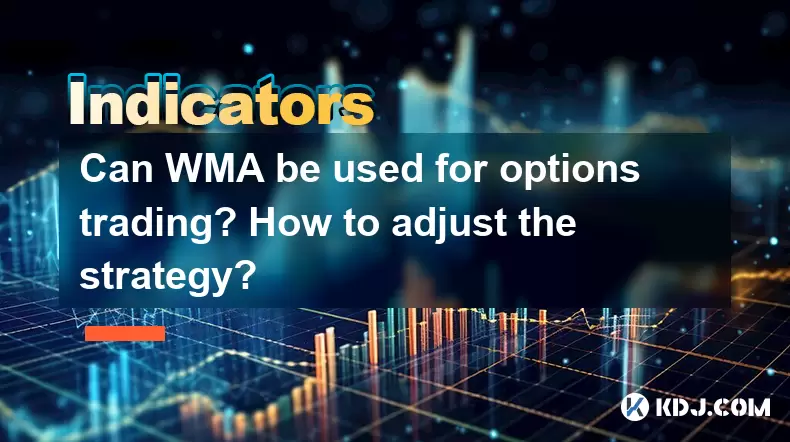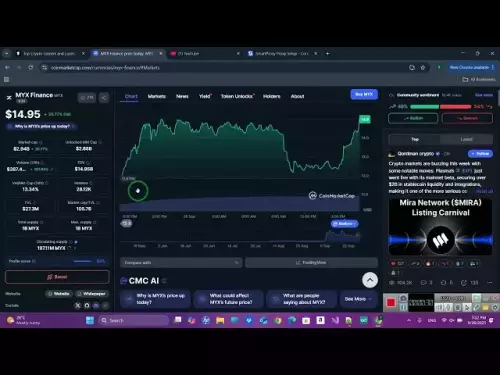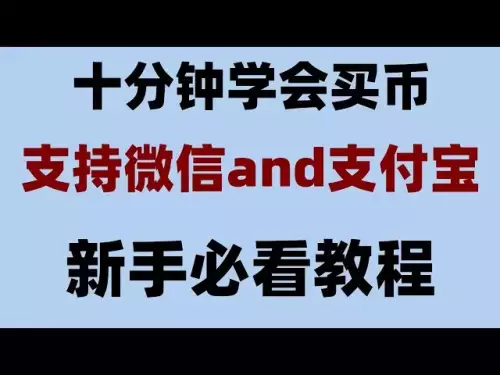-
 bitcoin
bitcoin $109547.008142 USD
0.04% -
 ethereum
ethereum $4011.838726 USD
-0.05% -
 tether
tether $1.000402 USD
-0.01% -
 xrp
xrp $2.798606 USD
0.88% -
 bnb
bnb $970.877944 USD
1.39% -
 solana
solana $202.237275 USD
-0.95% -
 usd-coin
usd-coin $0.999673 USD
0.00% -
 dogecoin
dogecoin $0.229294 USD
-1.15% -
 tron
tron $0.336370 USD
-0.45% -
 cardano
cardano $0.777260 USD
-1.66% -
 hyperliquid
hyperliquid $45.503019 USD
1.73% -
 ethena-usde
ethena-usde $1.000362 USD
0.01% -
 chainlink
chainlink $20.785303 USD
-1.10% -
 avalanche
avalanche $28.755822 USD
-0.11% -
 stellar
stellar $0.358303 USD
-0.48%
Can WMA be used for options trading? How to adjust the strategy?
WMA helps crypto options traders identify trends and time trades, using signals to buy call or put options based on price movements relative to the WMA line.
May 21, 2025 at 08:21 pm

Introduction to WMA in Options Trading
The Weighted Moving Average (WMA) is a popular technical analysis tool used in the cryptocurrency trading community to identify potential trends and make informed trading decisions. While WMA is traditionally used for trend analysis in spot trading, many traders wonder if it can also be effectively used for options trading within the crypto space. This article delves into the application of WMA in options trading, explores how to adjust strategies based on WMA signals, and provides detailed guidance on implementing these strategies.
Understanding WMA and Its Application in Options Trading
WMA calculates the average of a set of data points, giving more weight to recent prices. This makes it particularly useful for traders looking to capture short-term trends. In options trading, which involves contracts that give the buyer the right, but not the obligation, to buy or sell an underlying asset at a predetermined price, WMA can be used to determine optimal entry and exit points for these contracts.
In the context of cryptocurrency options trading, WMA can help traders identify when to buy call options (expecting the price of the underlying asset to rise) or put options (expecting the price to fall). By analyzing the WMA, traders can time their options trades to capitalize on anticipated price movements.
Setting Up WMA for Options Trading
To effectively use WMA in options trading, traders must first set up their trading platform to display WMA. Here's how to do it:
- Choose a trading platform that supports cryptocurrency options trading and technical analysis tools.
- Navigate to the chart settings and select the option to add a WMA indicator.
- Adjust the period for the WMA. A shorter period (e.g., 10-20 days) is more sensitive to recent price changes, suitable for short-term options trading, while a longer period (e.g., 50-200 days) may be better for longer-term trends.
- Customize the WMA settings if the platform allows, such as changing the color and thickness of the line for better visibility.
Interpreting WMA Signals for Options Trading
Once the WMA is set up, traders need to interpret its signals to make informed decisions about options trading. Here's how to do it:
- Uptrend Signal: When the price of the underlying cryptocurrency consistently stays above the WMA line, it indicates an uptrend. This is a signal to consider buying call options, as the price is expected to continue rising.
- Downtrend Signal: Conversely, when the price consistently stays below the WMA line, it suggests a downtrend. This is a signal to consider buying put options, as the price is expected to keep falling.
- Crossover Signal: A crossover occurs when the price crosses above or below the WMA line. An upward crossover (price moving from below to above the WMA) can be a buy signal for call options, while a downward crossover (price moving from above to below the WMA) can be a buy signal for put options.
Adjusting Options Trading Strategies Based on WMA
Adjusting trading strategies based on WMA involves several key steps:
- Monitor the WMA Closely: Regularly check the WMA on your chosen cryptocurrency to stay updated on the latest trends. This helps in deciding whether to enter or exit an options position.
- Set Price Targets: Use the WMA to set realistic price targets for your options trades. For instance, if the WMA indicates a strong uptrend, you might set a higher target for your call options.
- Adjust Option Expiry: Depending on the WMA signals, you might choose shorter or longer expiry dates for your options. A strong short-term trend indicated by a short-period WMA might warrant shorter expiry options to capitalize on quick movements.
- Diversify Options Types: Consider using both call and put options based on WMA signals. If the WMA suggests a potential reversal, you might hedge your position by buying both types of options.
Practical Example of Using WMA in Options Trading
Let's consider a practical example to illustrate how WMA can be used in options trading within the cryptocurrency market:
- Scenario: You are trading Bitcoin options and notice that the 20-day WMA is trending upwards, with the price consistently above the WMA line.
- Action: Based on this signal, you decide to buy a call option on Bitcoin with a strike price slightly above the current market price and an expiry date of one month.
- Monitoring: You continue to monitor the WMA. If the price stays above the WMA and the WMA continues to trend upwards, you might hold the option until expiry or sell it for a profit before expiry.
- Adjustment: If the WMA starts to flatten or turn downwards, indicating a potential reversal, you might consider selling the call option or buying a put option to hedge your position.
Risks and Considerations When Using WMA in Options Trading
While WMA can be a powerful tool, there are several risks and considerations to keep in mind:
- False Signals: WMA, like any technical indicator, can produce false signals. It's crucial to use WMA in conjunction with other indicators and market analysis to validate signals.
- Volatility: Cryptocurrency markets are known for their high volatility, which can affect the accuracy of WMA signals. Options traders must be prepared for rapid price swings that can impact their positions.
- Time Decay: Options are subject to time decay, meaning their value decreases as they approach expiry. Traders must consider this when using WMA to time their trades.
FAQs
Q: Can WMA be used effectively for long-term options trading in cryptocurrencies?A: While WMA is typically more suited for short-term trading due to its sensitivity to recent price changes, it can be used for long-term options trading by adjusting the period to a longer timeframe (e.g., 50-200 days). This allows traders to capture broader trends and make longer-term options decisions based on these trends.
Q: How does the choice of WMA period affect options trading strategies?A: The choice of WMA period directly impacts the sensitivity of the indicator to price changes. A shorter period (e.g., 10-20 days) is more responsive to recent price movements, making it suitable for short-term options trading strategies. A longer period (e.g., 50-200 days) is less sensitive and better suited for longer-term strategies, as it captures broader trends.
Q: Are there any specific cryptocurrencies that are more suitable for WMA-based options trading?A: While WMA can be applied to any cryptocurrency, it is often more effective with highly liquid assets like Bitcoin and Ethereum. These cryptocurrencies have more data points and less volatility compared to smaller altcoins, making WMA signals more reliable for options trading.
Q: How can traders combine WMA with other technical indicators for options trading?A: Traders can enhance their options trading strategies by combining WMA with other technical indicators such as the Relative Strength Index (RSI) for overbought/oversold signals, Bollinger Bands for volatility analysis, and Moving Average Convergence Divergence (MACD) for trend confirmation. Using multiple indicators helps validate WMA signals and provides a more comprehensive view of market conditions.
Disclaimer:info@kdj.com
The information provided is not trading advice. kdj.com does not assume any responsibility for any investments made based on the information provided in this article. Cryptocurrencies are highly volatile and it is highly recommended that you invest with caution after thorough research!
If you believe that the content used on this website infringes your copyright, please contact us immediately (info@kdj.com) and we will delete it promptly.
- BlockchainFX, Binance Coin, Cardano: Decoding the Crypto Landscape in 2025
- 2025-09-29 04:45:12
- Cathie Wood, Bitcoin, and the Future of Monetary Standards: A New York Perspective
- 2025-09-29 04:25:17
- Crypto Presales Under the Microscope: BlockDAG, HYPER, and the Hunt for the Next Big Thing
- 2025-09-29 04:25:17
- Ethereum Bulls Eye $4,000: Is the Rally Sustainable?
- 2025-09-29 05:05:14
- Aster Price Surge: Bullish Breakout or Falling Wedge Fiasco?
- 2025-09-29 04:45:12
- Aptos Price Prediction: Will the Velociraptor Upgrade Trigger a Rally?
- 2025-09-29 04:50:01
Related knowledge

What is a tower bottom candlestick pattern? Does it have a high success rate?
Sep 22,2025 at 07:18am
Tower Bottom Candlestick Pattern Explained1. The tower bottom candlestick pattern is a reversal formation that typically appears at the end of a downt...

What is a black hole pattern in the MACD indicator? Is it a cause for concern?
Sep 21,2025 at 06:54pm
Bitcoin's Role in Decentralized Finance1. Bitcoin remains the cornerstone of decentralized finance, serving as a benchmark for value and security acro...

How can I use the psychological line (PSY) to determine market sentiment?
Sep 17,2025 at 02:19pm
Understanding the Psychological Line (PSY) in Cryptocurrency TradingThe Psychological Line, commonly referred to as PSY, is a momentum oscillator used...

How can I determine if a double top pattern has officially formed?
Sep 21,2025 at 03:18am
Understanding the Structure of a Double Top Pattern1. A double top pattern consists of two distinct peaks that reach approximately the same price leve...

What is the Golden Valley pattern on the moving average? Is it better than the Silver Valley pattern?
Sep 21,2025 at 02:54pm
Understanding the Golden Valley Pattern in Moving Averages1. The Golden Valley pattern is a technical formation observed in cryptocurrency price chart...

What does a death cross of the RSI in the strong zone (above 50) mean?
Sep 17,2025 at 10:54pm
Understanding the Death Cross in RSI Context1. The term 'death cross' is traditionally associated with moving averages, where a short-term average cro...

What is a tower bottom candlestick pattern? Does it have a high success rate?
Sep 22,2025 at 07:18am
Tower Bottom Candlestick Pattern Explained1. The tower bottom candlestick pattern is a reversal formation that typically appears at the end of a downt...

What is a black hole pattern in the MACD indicator? Is it a cause for concern?
Sep 21,2025 at 06:54pm
Bitcoin's Role in Decentralized Finance1. Bitcoin remains the cornerstone of decentralized finance, serving as a benchmark for value and security acro...

How can I use the psychological line (PSY) to determine market sentiment?
Sep 17,2025 at 02:19pm
Understanding the Psychological Line (PSY) in Cryptocurrency TradingThe Psychological Line, commonly referred to as PSY, is a momentum oscillator used...

How can I determine if a double top pattern has officially formed?
Sep 21,2025 at 03:18am
Understanding the Structure of a Double Top Pattern1. A double top pattern consists of two distinct peaks that reach approximately the same price leve...

What is the Golden Valley pattern on the moving average? Is it better than the Silver Valley pattern?
Sep 21,2025 at 02:54pm
Understanding the Golden Valley Pattern in Moving Averages1. The Golden Valley pattern is a technical formation observed in cryptocurrency price chart...

What does a death cross of the RSI in the strong zone (above 50) mean?
Sep 17,2025 at 10:54pm
Understanding the Death Cross in RSI Context1. The term 'death cross' is traditionally associated with moving averages, where a short-term average cro...
See all articles









































































